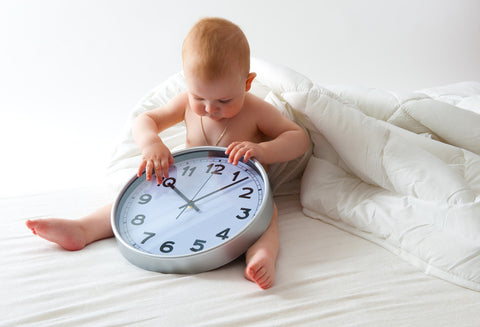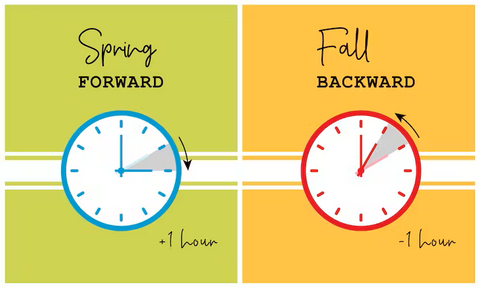Daylight Saving Time and Babies
As daylight saving time (DST) approaches, parents around the world brace themselves for potential disruptions to their little ones' sleep routines. The biannual time change can be challenging for babies and toddlers who thrive on consistency and predictability. But fear not! With some strategic planning, you can help your child (and yourself!) navigate the time change without hassle. In this blog post, we'll explore practical tips to assist babies and toddlers in adjusting to daylight-saving time changes in spring and fall.
How will daylight saving time affect my baby?

The transition between "spring forward" and "fall back" involves “only” a one-hour time adjustment, yet even this slight change can impact your child's sleep patterns. Some early risers may awaken even earlier than usual with the clock's shift. In contrast, other babies may struggle with bedtime, potentially becoming overtired as they attempt to adapt to the new hour.
Here are some potential ways DST can impact your baby:
- Disrupted Sleep Patterns: The shift in time can disrupt your baby's internal clock, leading to changes in their sleep schedule. Babies may have difficulty adjusting to the new bedtime and wake-up time.
- Fussiness and Irritability: Babies who are already sensitive to routine changes may become fussier or more irritable during the adjustment period.
- Shorter Naps: Babies may have shorter naps or difficulty falling asleep for naps due to the change in daylight hours.
- Hungrier or Less Hungry: The time change may affect Babies' feeding schedules, leading them to be hungrier or less hungry at certain times of the day.
8 Tips: How to Prepare Your Baby for Daylight-Saving Time
As Daylight Saving Time arrives, parents may anticipate challenges adjusting their baby's sleep schedule to accommodate the time change. Preparing your little one for the change as well as possible can help maintain consistency in their sleep patterns and minimize disruptions. With that in mind, here are eight practical tips to assist you in preparing your baby for the upcoming Daylight Saving Time adjustment:
- Start Gradually: Several days before the time change, gradually adjust your baby's bedtime and nap schedule. Shift their bedtime and wake-up time by 10-15 minutes each day leading up to daylight-saving time.
- Stick to Routine: Maintain consistency in your baby's bedtime routine. Follow the same calming activities such as reading, singing, or gentle rocking before bedtime to signal that it's time to wind down and sleep.
- Adjust Meal Times: If your baby's feeding schedule is closely tied to their sleep routine, gradually adjust meal times to align with the new schedule.
- Expose to Natural Light: Natural light helps regulate your baby's internal clock. During the day, spend time outdoors with your baby, especially in the morning, to help reset their rhythm.
- Create a Relaxing Sleep Environment: Ensure your baby's sleep environment is good for resting. Keep the room dark, quiet, and at a comfortable temperature. Consider using white noise or soothing music to drown out any external noises. Tip: Check our 5 best lullabies at the end of this blog!
- Monitor Sleep Cues: Pay attention to your baby's sleep cues and adjust their schedule accordingly. If your baby shows signs of tiredness earlier or later than usual, be flexible and adapt their nap and bedtime accordingly.
- Be Patient and Flexible: It may take time for your baby to adjust to the new schedule. Be patient and offer comfort if they have difficulty falling asleep or waking up during the night.
- Take Care of Yourself: Daylight-saving time changes can also be stressful for parents. Make sure to prioritize your own sleep and well-being during this transition. Rest when you can and seek support from family and friends if needed.
How long can it take for newborns and toddlers to adjust to or from daylight saving time?
The time it takes for babies and toddlers to adjust to daylight saving time changes can vary from child to child. Generally, babies and toddlers may take a few days to a week to fully adapt to the new schedule. During this adjustment period, you may notice changes in your child's sleep patterns, such as difficulty falling asleep, waking up earlier than usual, or shorter naps. Again, being patient and consistent with your child's sleep routine during this time is important.
Difference in approach between “Spring Forward” and “Fall Back”

The approaches to managing daylight-saving time changes for babies can differ between "Spring Forward" and "Fall Back" due to the direction of the time shift and its impact on sleep patterns. Here's the difference in approaches of both:
"Spring Forward" (Moving the Clock Forward)
"Springing forward" on the second Sunday in March means moving forward your clocks by an hour, which results in losing an hour of sleep (Noooo!). This adjustment can be particularly challenging for babies and children. For instance, if your little one typically goes to bed at 7 p.m., it effectively becomes 6 p.m. according to their internal clock, and they may not feel tired. Here are two strategies to help your baby or toddler adapt to the time change:
- Maintain Routine: Initially, you can choose to maintain your baby's regular bedtime despite the time change. For instance, if their bedtime is typically 7 p.m., continue putting them down according to the clock and wake them at their usual wake-up time. Although they may be extra tired and cranky for a few days, they'll likely adjust and fall asleep more easily.
- Gradual Adjustment: Alternatively, you can gradually introduce an earlier bedtime in the days leading up to Daylight Saving Time (DST). Here's a plan to help your baby adapt to springing forward:
- Four days before DST: Adjust your baby's bedtime to 6:45 p.m., ensuring their wakeup time shifts 15 minutes earlier.
- Three days before DST: Move bedtime to 6:30 p.m.
- Two days before DST: Shift bedtime to 6:15 p.m.
- One day before DST: Set bedtime for 6 p.m.
Here are some more handy tips:
- Exposure to Natural Light: Encouraging exposure to natural light in the morning can help reset the baby's internal clock and signal the start of the day. Taking morning walks or spending time near windows can help synchronize the baby's circadian rhythm with the new schedule.
- Consistent Bedtime Routine: Maintaining a consistent bedtime routine is crucial during transition. Bedtime rituals such as reading, bathing, and soothing activities should remain consistent to help signal to the baby that it's time to wind down and sleep.
- Flexibility and Patience: Parents should be patient and understanding during the adjustment period, as babies may experience some disruptions in their sleep patterns. Offering comfort and reassurance during nighttime awakenings can help ease the transition.
"Fall Back" (Moving the Clock Backward)
After Daylight-Saving Time ends on the first Sunday in November, and you “fall back,” your baby may wake up an hour early—and sometimes that’s too early. One way to help the time change go more smoothly is to put your baby to bed a little later each night as DST approaches. If 7 p.m. is your baby’s usual bedtime, you can fall back by taking the following steps:
- Four days before DST, put your baby to bed at 7:15 p.m.
- Three days before DST, move bedtime to 7:30 p.m.
- Two days before DST, move bedtime to 7:45 p.m.
- One day before DST, put your baby down at 8 p.m.
Here are some more handy tips:
- Seize the Extra Hour: Parents often look forward to "Fall Back" as it provides an extra hour of sleep (Yeaah!). However, babies may still wake up at their usual time, leading to a potential shift in their sleep schedule. Some babies may wake earlier than usual due to the time change.
- Gradual Adjustment: While the "Fall Back" time change typically offers more flexibility, parents can gradually adjust the baby's schedule if needed. Incrementally shifting bedtime and wake-up times by 10-15 minutes can help prevent disruptions to the baby's sleep routine.
- Maintain Consistency: Even with the extra hour gained, it's important to maintain consistency in the baby's bedtime routine. Consistent sleep cues and rituals help signal the baby that it's time to sleep, regardless of the time change.
- Be Prepared for Changes: Parents should be prepared for potential changes in the baby's sleep patterns during the transition period. Some babies may take a few days to adjust to the new schedule, while others may adapt more quickly.
In summary, while the approaches to managing DST changes may vary slightly between "Spring Forward" and "Fall Back," the fundamental principles remain the same: gradual adjustment, exposure to natural light, consistency in bedtime routines, and patience and flexibility to accommodate the baby's needs during the transition period.
Daylight Saving Time in the United States from 2024 to 2028:
If you’re wondering when the time changes for Daylight Saving Time or when we “spring forward” or “fall back,” check out the table below. We’ve listed the relevant dates for the next five years to help you plan.
Here is the schedule for DST in the United States from 2024 to 2027:
2024:
- Spring Forward: March 10
- Fall Back: November 3
2025:
- Spring Forward: March 9
- Fall Back: November 2
2026:
- Spring Forward: March 8
- Fall Back: November 1
2027:
- Spring Forward: March 14
- Fall Back: November 7
Please note that the dates provided are based on the standard schedule observed in the US. It's essential to verify the specific dates for Daylight Saving Time changes in your region, as they may vary depending on local regulations and practices.
Classic Lullabies 😉

As mentioned in this blog, here are some lullabies that can help your little one fall asleep. Lullabies are a wonderful way to soothe babies and help them drift off to sleep, especially during the time change associated with Daylight Saving Time. Here are five classic lullabies that you can sing to your baby:
- "Twinkle, Twinkle, Little Star": This timeless lullaby is gentle and melodic, making it perfect for calming babies and toddlers before bedtime.
- "Hush, Little Baby": With its soothing melody and reassuring lyrics, "Hush, Little Baby" is a comforting lullaby that can help ease your baby into sleep.
- "Brahms' Lullaby": Also known as "Lullaby and Goodnight," this classical piece by Johannes Brahms has a gentle, repetitive melody that can help lull your baby to sleep.
- "Rock-a-Bye Baby": This traditional lullaby is familiar to many parents and features a soothing melody that can help calm fussy babies and encourage sleep.
- "All Through the Night": This Welsh lullaby has a beautiful, soothing melody and lyrics that evoke a sense of comfort and security, making it ideal for bedtime.
These lullabies, sung softly and with love, can create a peaceful atmosphere and help your baby relax during the transition associated with Daylight Saving Time.
Conclusion
Daylight-saving time changes can present challenges for parents of babies and toddlers, but with careful planning and patience, you can help your child adjust smoothly. Starting early, maintaining consistency, and creating a calm sleep environment can minimize disruptions to your child's sleep routine during the transition. Remember to be patient and flexible as your child adapts to the new schedule, and trust that they will eventually settle into their revised sleep routine.
And remember dear parents: this too shall pass. With a bit of planning, patience, and a lot of love (and maybe a lullaby or two), you'll navigate the time change like a boss. Here's to peaceful nights and well-rested babies! 🌞✨
Formula Related Questions?
Organic Formula Shop offers safe European formulas that will give you peace of mind and comfort. It’s key to know that you are giving your baby nutrition that mimics breast milk as closely as possible and is made with premium organic ingredients. Contact our dedicated customer support team at Organic Formula Shop for expert advice and guidance tailored to your baby's needs. They have earned hundreds of 5-star reviews from our customers, helping you to provide the best nutrition for your little one. Contact us here or shoot us an email at support@organicformulashop.com.
Please note:
This article is not medical advice.




